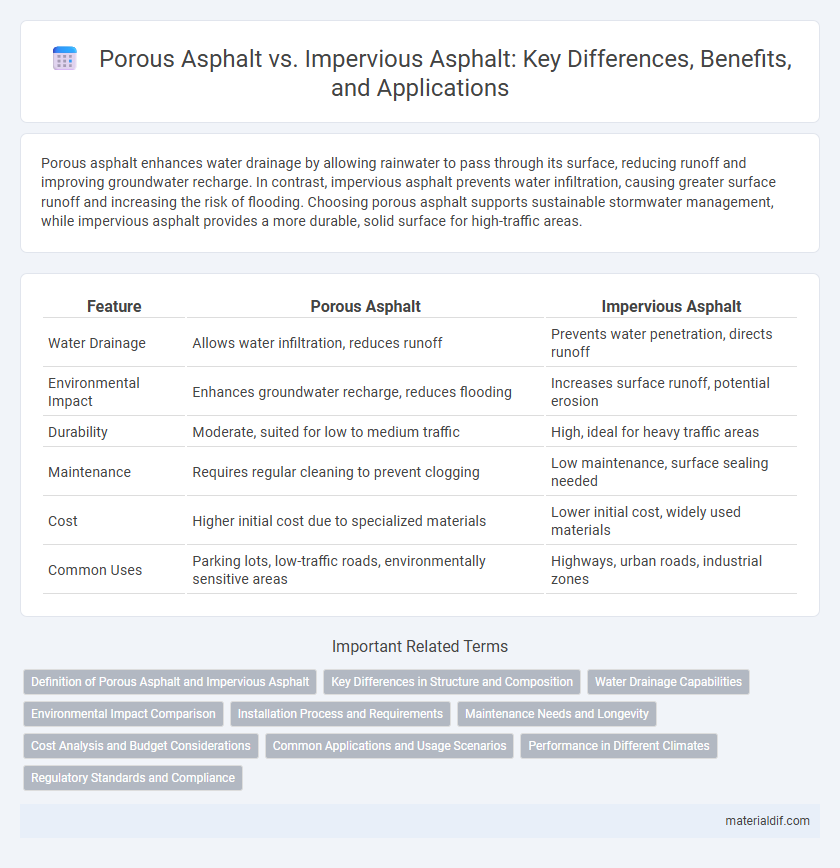Porous asphalt enhances water drainage by allowing rainwater to pass through its surface, reducing runoff and improving groundwater recharge. In contrast, impervious asphalt prevents water infiltration, causing greater surface runoff and increasing the risk of flooding. Choosing porous asphalt supports sustainable stormwater management, while impervious asphalt provides a more durable, solid surface for high-traffic areas.
Table of Comparison
| Feature | Porous Asphalt | Impervious Asphalt |
|---|---|---|
| Water Drainage | Allows water infiltration, reduces runoff | Prevents water penetration, directs runoff |
| Environmental Impact | Enhances groundwater recharge, reduces flooding | Increases surface runoff, potential erosion |
| Durability | Moderate, suited for low to medium traffic | High, ideal for heavy traffic areas |
| Maintenance | Requires regular cleaning to prevent clogging | Low maintenance, surface sealing needed |
| Cost | Higher initial cost due to specialized materials | Lower initial cost, widely used materials |
| Common Uses | Parking lots, low-traffic roads, environmentally sensitive areas | Highways, urban roads, industrial zones |
Definition of Porous Asphalt and Impervious Asphalt
Porous asphalt is a type of pavement designed with interconnected voids that allow water to infiltrate through the surface, reducing runoff and promoting groundwater recharge. Impervious asphalt, by contrast, is a dense, non-porous material that prevents water infiltration, causing surface runoff which can lead to increased flooding and erosion. The primary difference lies in the permeability, where porous asphalt supports sustainable drainage systems and impervious asphalt prioritizes structural durability and water resistance.
Key Differences in Structure and Composition
Porous asphalt features interconnected void spaces, allowing water to permeate through the pavement and reduce surface runoff, while impervious asphalt consists of a dense, compacted mix with minimal voids that prevents water infiltration. The structure of porous asphalt uses larger aggregates combined with an open-graded binder to maintain permeability, contrasting with the fine aggregate and tight compaction of impervious asphalt that ensures durability and water resistance. These compositional differences directly affect drainage performance, maintenance needs, and environmental impact in pavement applications.
Water Drainage Capabilities
Porous asphalt features interconnected voids that allow water to filter through the pavement surface, significantly reducing surface runoff and enhancing groundwater recharge. Impervious asphalt, by contrast, creates a sealed surface that prevents water infiltration, leading to increased stormwater runoff and potential flooding issues. Effective water management favors porous asphalt for sustainable urban drainage systems and pollution control.
Environmental Impact Comparison
Porous asphalt significantly reduces stormwater runoff by allowing water to permeate through its surface, promoting groundwater recharge and reducing the risk of flooding and erosion compared to impervious asphalt. Impervious asphalt, by contrast, prevents water infiltration, leading to increased surface runoff, higher pollutant loads in waterways, and greater strain on urban drainage systems. The use of porous asphalt contributes to improved water quality and mitigates urban heat island effects, making it a more environmentally sustainable choice for pavement.
Installation Process and Requirements
Porous asphalt requires a layered installation process involving a deep, well-graded aggregate base that facilitates water drainage, along with precise compaction to maintain permeability. Impervious asphalt demands a smoother base with fewer permeability considerations and tighter compaction to create a sealed, water-resistant surface. Proper installation of porous asphalt includes specialized filtration layers and careful attention to preventing clogging, while impervious asphalt prioritizes surface durability and weather resistance.
Maintenance Needs and Longevity
Porous asphalt requires more frequent maintenance such as vacuum sweeping and timely repairs to maintain its permeability and prevent clogging, directly impacting its service life. Impervious asphalt generally demands less frequent maintenance but may suffer from drainage-related issues that can shorten its lifespan if not properly managed. The longevity of porous asphalt typically ranges between 10 to 15 years with regular upkeep, whereas impervious asphalt can last 15 to 20 years under optimal conditions.
Cost Analysis and Budget Considerations
Porous asphalt generally incurs higher initial costs due to specialized materials and installation processes, but it offers long-term savings in stormwater management and reduced drainage infrastructure expenses. Impervious asphalt has lower upfront costs but may lead to increased expenses from runoff control and environmental compliance over time. Budget considerations must weigh immediate installation costs against potential maintenance savings and regulatory benefits associated with porous asphalt systems.
Common Applications and Usage Scenarios
Porous asphalt is commonly used in parking lots, pedestrian walkways, and low-traffic areas to facilitate stormwater management by allowing water to permeate through the surface, reducing runoff and improving groundwater recharge. Impervious asphalt is typically applied in high-traffic roads, highways, airport runways, and heavy-duty pavements where strong durability and water resistance are essential to prevent water damage and maintain structural integrity. Choosing between porous and impervious asphalt depends on specific environmental goals, traffic volume, and site drainage requirements.
Performance in Different Climates
Porous asphalt enhances water drainage and reduces surface runoff, making it ideal for wet climates by preventing hydroplaning and ice formation. Impervious asphalt offers superior durability and resistance to freeze-thaw cycles, which benefits regions with harsh winters and heavy snowfall. Both types vary in maintenance needs, with porous asphalt requiring regular cleaning to maintain permeability, while impervious asphalt demands fewer interventions in dry, stable climates.
Regulatory Standards and Compliance
Porous asphalt complies with environmental regulations such as the Environmental Protection Agency (EPA) guidelines due to its permeability, which facilitates stormwater management and reduces runoff pollution. Impervious asphalt must meet standards for durability and load-bearing capacity dictated by the American Society for Testing and Materials (ASTM) and Department of Transportation (DOT) to ensure structural compliance. Both asphalt types require adherence to local regulatory agencies' specifications to qualify for public infrastructure projects and urban development permits.
Porous Asphalt vs Impervious Asphalt Infographic

 materialdif.com
materialdif.com